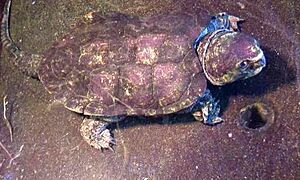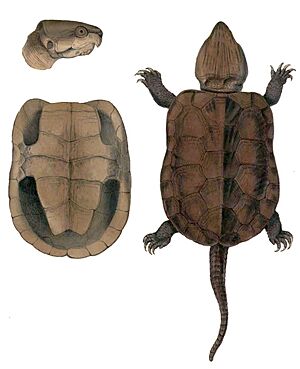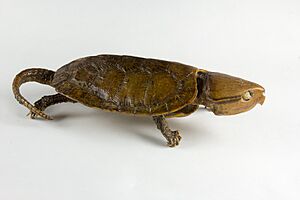Big-headed turtle facts for kids
Quick facts for kids Big-headed turtle |
|
|---|---|
 |
|
| A big-headed turtle (Platysternon megacephalum) | |
| Conservation status | |
| Scientific classification | |
| Genus: |
Platysternon
|
| Species: |
megacephalum
|
| Synonyms | |
|
|
The big-headed turtle (Platysternon megacephalum) is a unique species of turtle. It belongs to the family Platysternidae. You can find these turtles in Southeast Asia and southern China.
Contents
About the Big-Headed Turtle
This turtle gets its name from its very large head. Its head is so big that it cannot pull it inside its shell for protection. Instead, it has a strong, armored head and a sharp beak to defend itself.
Where Big-Headed Turtles Live
You can find the big-headed turtle in countries like Cambodia, China, Laos, Myanmar, Thailand, and Vietnam. They usually live in places with fast-moving water, such as streams and waterfalls, especially in rocky areas.
How Big-Headed Turtles Behave
Big-headed turtles are amazing climbers! They can climb over rocks and other things in rivers and streams. They use their strong claws and their tail to help them reach higher. Their beak also helps them climb. There have even been reports of them climbing trees and bushes.
These turtles are more active at night. They don't usually travel very far each day. Males tend to move a bit more than females. They are not very strong swimmers. When they do swim, they sometimes arch their tail like a scorpion. Since they can't hide their head in their shell, they will use their powerful jaws to protect themselves if they feel threatened.
What Big-Headed Turtles Eat
Big-headed turtles are opportunistic feeders, meaning they eat whatever food they can find. They were once thought to eat only meat, but now we know they eat many different things. Their diet includes fish, snails, and worms. They also enjoy eating fruits, like those from the Machilus tree. They also eat insects, crabs, and mollusks.
Scientists have studied what these turtles eat by looking at their waste. They found that big-headed turtles eat fruits, many types of insects (like beetles, flies, and mantises), mollusks, frogs, small rodents, and freshwater crabs. What they eat can change depending on what's available in their environment. Interestingly, when they eat fruits, the seeds often grow better after passing through the turtle. This means they might help spread plants in their habitat!
Threats to Big-Headed Turtles
Sadly, big-headed turtles are often caught and sold illegally. They are sometimes eaten in Asia and are also popular in the pet trade. Hunters often catch them using lines with baited hooks. Because of this, their numbers are quickly decreasing in the wild.
Types of Big-Headed Turtles
There are three main types, or subspecies, of the big-headed turtle:
- P. m. megacephalum: Found in China, described in 1831.
- P. m. peguense: Found in Myanmar and Thailand, described in 1870.
- P. m. shiui: Found in Cambodia, Laos, and Vietnam, described in 1987.




